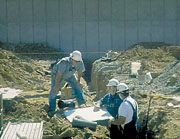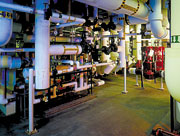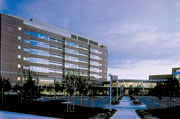

The University of Colorado Hospital (UCH) specifically elected to use the D-B method to achieve scheduling, budgetary, and quality objectives. The D-B team of Phipps/McCarthy (Denver); H+L (Denver)/HDR Architecture (Omaha, NE) a joint venture; Murphy Company (St. Louis); and Sturgeon/Sacs Electric (Henderson, CO) was carefully selected to ensure all of these goals were achieved. It was the interaction between team members that gave the group the necessary foundation to push the performance envelope.
It was critical to the project to provide UCH with a new and operable outpatient facility within a 24-month timeframe. UCH planned to construct a new outpatient facility near its main campus in midtown Denver. At about this time, the former Fitzsimons building became available for private development. The UCH seized on the opportunity to develop the Fitzsimons site instead of continuing with its original plans for locating AOP on the property adjacent to its urban campus.
The university soon realized that the months spent on plans for the AOP would be lost because the Fitzsimons campus was less restrictive and allowed for a significantly different approach to design than the original proposed AOP site did.
The new challenge to the D-B team was to redesign and build the facility on the new location in the same time parameters as the original project. "We chose the joint venture approach because they presented the combination of a strong contractor with a capable architectural team. They convinced us they could work with us to develop our vision of a center of excellence focused on patient care," said Julia Fitzpatrick, UCH director of facilities.
Although the main challenge of the project was design and construction speed, there were many other challenges as well in creating a complex, patient-focused, forward-looking health care facility.
The Murphy Company met those challenges with engineered flexibility, coordination, and safety as priorities. Murphy was responsible for the mechanical, plumbing, and medical gas engineering and construction.
To help facilitate the fast-track schedule, an early guaranteed maximum price (GMP) was issued in August 1999 after design development drawings were completed. The GMP was verified upon completion of construction documents and final buyout of the subcontracts in January 2000.
The project's goals were:
- To design and construct the project within the original schedule planned for a different building on a completely different site.
- To create a world-class "center for advanced medicine."
- To establish and develop design standards for the entire 217-acre health campus yet to be constructed.
- To develop a creative and flexible design to best achieve the UCH mission.
Flexibility in Design
From the very beginning of the project, the challenge was to keep on schedule while the owner continued to make changes and decisions about the project. At the beginning, the project's design was a six-floor, 265,000-sq-ft-building, with a price tag of $65 million. As UCH refined and finalized its program requirements, six months into the project it increased to a $100 million, eight-floor, 476,000-sq-ft-building.
Three months into design, with a basic footprint and function of the building, the Murphy team designed a flexible mechanical system with enough details and locations to allow the architectural/structural design to proceed and order key structural elements. Keeping a flexible design while coordinating with the architectural and structural design allowed the project to proceed at the pace necessary to keep up with the construction efforts.
Communication and Coordination
Weekly on-site construction meetings were held to enhance communication within the team. Murphy's on-site team led the effort with all MEP trades to coordinate systems prior to construction. Drawings were pinned up and overlaid with other industrys' work and reviewed sheet by sheet. Murphy's design team used 3-D design software to develop the arrangement and placement of the large air-handling equipment in the mechanical penthouse.
Using 3-D technology, the design team was able to identify equipment, duct, and structural obstructions to develop the equipment configuration. To expedite the installation of major building piping, Murphy used 3-D pipe design-modeling software to simultaneously produce design and fabrication drawings. Each major system was designed independent of other systems, but was fully coordinated with all the other systems.

All About Speed
One of the owner's top priorities was to have this project designed and constructed for initial occupancy within 24 months - a very aggressive schedule for a project of this size and complexity. So, from the moment the D-B team came on board in early 1999 speed was of paramount importance.The D-B process was selected primarily for the benefits it could provide to help meet the owner's schedule parameters. In the end, it was the successful implementation of this process that resulted in the project's success in meeting schedule and budget goals.
Using network and Internet technology, the Murphy team collected electronic copies of each trades' drawings and then compiled them into an increased scale composite drawing. The composite was then printed to an on-site plotter for review and approval by each trade. This released field craftsmen to focus on the installation of the systems rather than working out conflicts.
Key decisions were made early by the team which affected all the disciplines, including the basic clinic module/building footprint and functions, the structural grid and column locations, structural systems and bracing layout, major mechanical equipment and shaft locations total building height (including future expansion), and floor-to-floor heights.
Fabrication spool drawings were printed directly from Murphy's design team in St. Louis to the on-site office for prefabrication in the firm's Denver pipe fab shop. Trucks continuously delivered the prefabricated pipe from Murphy's office to the jobsite two miles away. The prefabricated piping was hoisted and distributed throughout the facility for final installation during the structure erection.
The D-B team incorporated other cooperative methods to keep the project on schedule and budget. First, the team proposed its staff be housed in the UCH administration building full time during the course of design development. Consequently, UCH provided conference room access and workspace for 18 people for more than five months. Hospital administrators were located just two floors above and visited the design office daily to review and comment on the team's progress.
As a result of this setup, decision-making was expedited and often took hours instead of days. The construction team was able to provide input on construction, cost estimating, and the schedule budget almost immediately, further streamlining the process.
Furthermore, the team developed mutual respect and cooperation that continued throughout the duration of the project through this arrangement.
Once construction began, a trailer compound was set up to house the entire project management staff. Having the design team on-site enabled communication to take place, which proved to be very effective in maintaining the schedule and reducing cost for the owner.
Weekly team and owner meetings were held in the trailer conference room. In addition, coordination review sessions were held with mechanical, electrical, plumbing, structural, and architectural representatives and reviewed drawings sheet by sheet.
Additionally, owner and user involvement was extensive throughout the project, including user group meetings made up of representatives from the medical staff meeting in week-long sessions with the team and continuous opportunities for input throughout the design and construction of the project through the use of mock-ups.
Designing Complexity
The challenge for the D-B team was to design a building that achieved the owner's mission and would be flexible enough to accommodate future changes in clinical or administrative needs, as well as to accommodate possible expansion. The H+L/HDR team accomplished the owner's goals by incorporating various elements.One was by designing the facility using a modular concept that enabled related medical clinics to work as "practice clusters" sharing staff, support services, and treatment areas. This adjacency also allows for easy expansion of clinic space.
Also, all patient/public circulation and waiting areas in the building were placed along the window walls. This allows for finding one's way around easily and affords spectacular views of the Rocky Mountains.
Physicians and staff elected to have space with views to ensure patients and other users were able to experience the magnificent surroundings. This "patient first" philosophy extends to the parking areas, as patients and visitors park closer to the building, and staff park in outlying areas.
A "front door/back door" concept was used to clearly separate the flow of materials, supplies, and staff from the flow of patients and visitors to make their experience as pleasant as possible.
The team value-engineered as they designed. Structural design issues were addressed early on: verification of the program, development and maintenance of the schematic parameters, prioritizing coordination items, and selecting solutions that were conducive to being designed and constructed quickly, allowing construction to begin three months after the notice to proceed.
Compounding the complexity of this highly technical yet fast-paced medical project, Murphy was required to provide a central plant of 1,750 tons of cooling for other critical projects under construction on the campus. The mission was accomplished and the central plant was designed, built, and operational prior to the completion of the AOP or any other project on the campus.
Enjoying 94 consecutive months without a lost-time accident, Murphy adopted the slogan appropriate for health care: "Safety is Contagious; SPREAD IT AROUND!" Murphy had a full-time safety director onsite to ensure a focused effort on safety, conducting daily pretask planning, daily safety meetings, and numerous safety audits throughout the month. This effort was critical under the extremely aggressive, fast-tracked schedule. The AOP was completed in over 100,000 hours without a lost-time accident.
Late-breaking Specs
To provide the most advanced, state-of-the-art equipment to its patients, UCH postponed providing the building team specific equipment information on the cyclotron, CAT scanner, PET scanner, and MRI equipment until the last minute to ensure they were incorporating the most advanced technologies into the facility.The team kept the project moving, working around these areas, and partially completing the slabs and other mechanical and electrical elements. When the owner selected the final equipment for installation, work then had to be expedited.
By establishing basic building parameters early, the Murphy Company was able to select and procure major equipment early. This allowed for the equipment to be delivered and installed as the structure was erected, preventing block-out areas that required returning later to complete.
The building skeleton was completed on Dec. 15, 1999 and by Jan. 15, 2000, approximately 355,000 lb of custom air-handling equipment had been hoisted and erected without any pause in the building construction. With the close integration of the MEP's engineering and construction teams, field construction proceeded within hours of completing the design for each equipment installation.
The eight-story structure was topped out less than one year after the design process began, a significant accomplishment considering the project size and that the program was not completed until six months into the design. The first drawings for construction were issued to the contractor March 15, a couple of months after the notice to proceed.
The success of the project is due to the problem-solving atmosphere that was created as all members of the group pulled together and worked as a cohesive team. This atmosphere was a direct result of the D-B process implemented on the project.
"This project was a success because it was not adversarial. We never stopped communicating. We never let issues become problems or problems become wars," says Jim West, the project's program manager and the vice president of Vanir.

A Job Well Done
On time and within budget through the engineering collaboration of the team, the new Anschutz Outpatient Pavilion provides Colorado residents with comprehensive outpatient and ambulatory care, consisting of 180 exam rooms, 30 procedures rooms, 31 clinics, six operating rooms, 10 invasive procedure rooms, 41 pre-/post-operative beds, and state-of-the-art equipment (CAT Scans, PET Scans, MRIs , etc.).The award-winning construction team achieved superior schedule and cost performance. This explains why the team was honored with the 2001 Design Build Institute of America's Award of Excellence (for the Best Project - Private Sector over $15 million).
In the end, the incredible speed of delivery the team safely achieved resulted in the project meeting all owner cost, quality, and program goals. "The team met and exceeded all of the expectations that the UCH team had of them. The challenging, large, dynamic project finished within schedule and budget," according to Julia Fitzpatrick, UCH's director of facilities. ES
